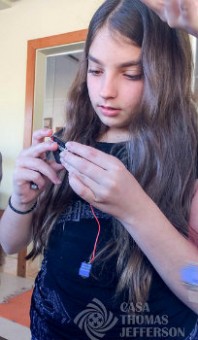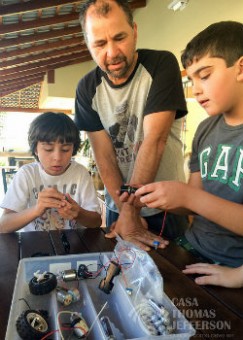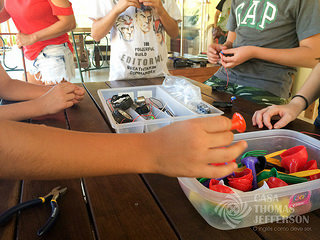Reinvent Summer Learning: Make It Up!
A MiddleWeb Blog

By the time my three sons bounced in the door for their highly anticipated summer vacation each year, I was already lining up ways to keep them engaged in mind-stretching activities. What sorts of creative things could they do and what kind of skills could they develop during this time?
I wish their teachers had banded together and sent home notes to parents with ideas for summer activities. I wish I had done the same all those years when I was a teacher. So, belatedly, I’ve written a letter to parents with steps they might take to stimulate summer sun, fun, and learning. With a STEM-related twist, of course!
Dear Parent or Summer Kid-Keeper,
Summer is a great time for sun and fun, but without your careful attention it can become a Summer Slide – a time when many learning gains your children made during the school year start slipping away. Can you do something about that? Absolutely! Instead of a Summer Slide, help them build a set of Summer Super Skills.
You may have heard about the “Maker Movement,” which involves children in invention-oriented learning. Try these “maker-friendly” ideas to help kids tap into their creative side and develop thinking skills and qualities to equip them for school and life in a 21st century world.
Encourage curiosity and questioning

For example: How can I . . . Stop the squirrel from getting to the bird feeder and eating the bird food? Design my own wind chimes? Make a new piece of furniture for my room? Build a robot? Design new fashion jewelry? Find a new use for some things around the house, like an old suitcase? Create a miniature garden? Remember to water our plants in a timely way?
Model curiosity for your children by talking aloud about things that you wonder about. Demonstrate how to carefully observe something, ask thoughtful questions about it, and make an informed guess about what the answers to those questions might be. Try thinking “out loud” so that your kids can hear you puzzling through possible solutions for a question. (Trust me, they are more likely to listen to you talk to yourself than to listen to you talk to them!)
Six summer “Make It Up” ideas
1. Set up a maker space. This is your home learning lab – a place in or around your home where children can make things and design solutions for their questions. You can locate ideas for how to do this by typing maker space into a search engine, or by searching sites such as Pinterest.
Basically, grab the largest available space and put up a table with baskets of materials on it. (You may not need the table, depending on the age of your kids.) Don’t worry if the area looks a bit messy. Think of this space as a learning lab for kids. This will be a place where they can pursue their own interests in making things and learn to work together with others to do so, in many cases.

One approach might be to go to a store that sells inexpensive items like coffee filters, craft sticks, glue, etc. Also consider going to a craft store or a hardware store and gathering up a variety of odds and ends.
Avoid getting kit materials with step-by-step approaches; you’re looking for materials that allow your child to explore different possible solutions, experiment, design, and create. One exception for middle school-aged kids might be something like Awesome Sylvia’s ideas for using Arduino microcontrollers in projects.
To solve the problems we face with the environment, medicine, and many other areas, children must be innovators – able to see things from a new perspective. So once you set up the area and supply the materials, step back and give your kids freedom to tinker, explore, and create.
3. Provide minimal guidance needed to encourage and keep kids focused. Questions such as “I wonder how I could build a (fill in the blank) with these materials?” might help them to generate ideas. Rather than giving them hints about an answer or a solution for a problem, encourage them to find information that can help them (perhaps online) and come up with several possible ideas for solutions.

No one learns much from getting something right the first time. It’s the mistakes we make that keep us learning and growing. In their STEM work during school, failure is simply a normal step in the learning process. Put this principle in place this summer and keep your kids’ home learning lab a place where failures are just quick stops along the road to success.
5. Encourage teamwork where appropriate. If more than one child is sharing this summer learning lab, help them with interpersonal skills as needed. Build a sense that they are working in a team to solve a problem, just as engineers do.
Before they begin working together, ask them to share some behaviors they value in other team members.Then help them to develop a list of ground rules they agree to follow, based on the behaviors they value. Encourage them to include concepts like respect others’ ideas, everyone plays a role, no one person dominates, etc. As they move forward, some gentle reminders from you can help them focus on these behaviors they need to be successful as a team.
6. Celebrate their experiences as they make and learn. Success involves more than coming up with a working solution. Celebrate the work they are doing and what they are learning. Let this be about fun and sharing. Whacky ideas and solutions are welcome!
Give your kids a summer full of relaxed, engaged, hands-on learning – time to explore, look for answers to questions, and keep their brain cells firing. Give them the thinking tools to invent and create the things we need as we go into the future – things that we have never imagined.
______
Cover image and other photos are from Casa Thomas Jefferson.































Thanks Anne for this wonderful article. I’m sending it right now to parents of all my gifted/enrichment students. It’s exactly what I plan to do with my students this coming school year!
Glad you find it useful, Julie! I hope your parents will find it useful as well.
What are the best procedural steps that can be followed by the teacher to teach his students the STEM?
Anne is away from her computer at the moment. A good place to start is her blog post, http://www.middleweb.com/9611/perfect-stem-lessons/. There’s more about the components of STEM and working with other educators here: http://www.middleweb.com/category/stem-by-design/